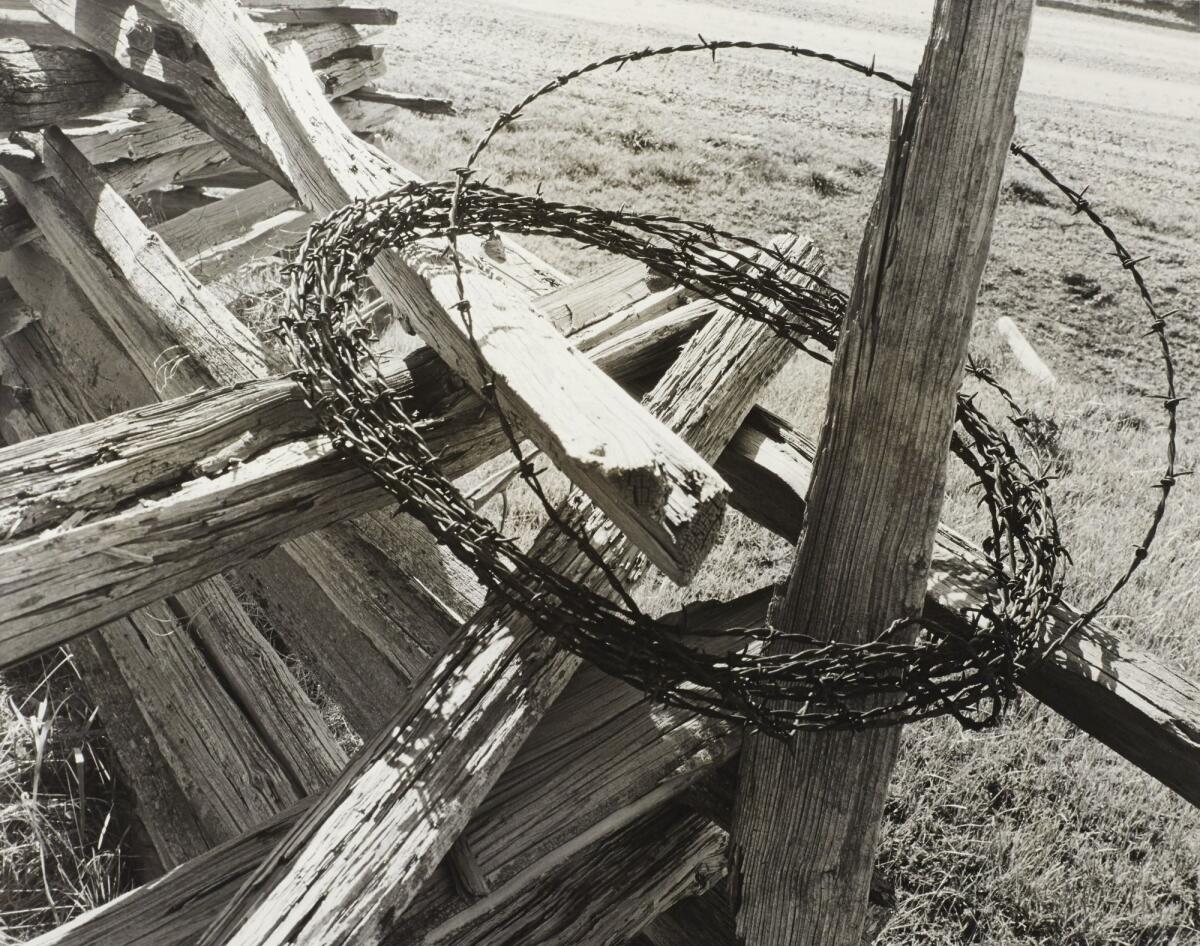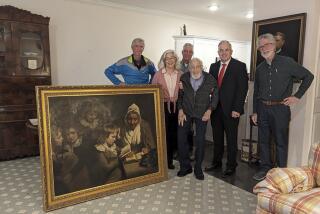Review: Minor White snaps into focus again in Getty Museum show

Is a revival of interest in the photographs of Minor White (1908-1976) worthwhile?
Once, White’s work was the epitome of all that art photography aspired to be. Since his death, however — and, actually, beginning several years before — his star has fallen.
The J. Paul Getty Museum thinks rehabilitation of White’s reputation is very much in order. A retrospective of his lush, poetically evocative silver gelatin prints is on view through Oct. 19. It’s the first such survey in a quarter-century, and it makes a very persuasive case.
------------
FOR THE RECORD:
Minor White review: In the Aug. 2 Calendar section, a review of “Minor White: Manifestations of the Spirit” at the J. Paul Getty Museum said that White studied art history with Meyer Schapiro at New York University. White studied with Schapiro at Columbia University.
------------
Among its 98 photographs and several artist’s books are works usually housed in the artist’s large archive at Princeton University, objects that have not been exhibited before. Among them is the 1948 handmade book “The Temptation of St. Anthony Is Mirrors,” an enigmatically titled suite of 32 photographs inspired by White’s student and model, Tom Murphy. It’s one of just two copies White made.
An addendum to the show further implies White’s legacy as a lifelong teacher and museum curator. His influence is reflected in a selection of 22 photographs by Paul Caponigro and Carl Chiarenza, well-known artists who studied with White at Rochester Institute of Technology in upstate New York.
Finally, the retrospective is accompanied by a large-format book. It features a smart interpretive essay that is a model of clarity and concision by the organizer, Getty curator Paul Martineau, plus lavish reproductions of everything in the show. Beautifully produced, it is especially unusual for an exhibition not currently scheduled to travel.
“Controversial, misunderstood and sometimes overlooked,” says the wall text introducing White in the first gallery. The observation borders on understatement. “Pointedly plowed under” might be closer to the truth.
Photography as an art form has undergone a dramatic transformation over the last 50 years. In America, the change begins with works like the snapshot-like image books of gas stations by Edward Ruscha, Andy Warhol’s silk-screen canvases in which found photographs from mass-media masquerade as paintings and the numinous photo-collages made with an early form of commercial copy machine by Wallace Berman.
The Modernist tradition, which regarded photographs as a separate, distinctive art form that could be as powerful as paintings or sculptures, began to unravel. White was arguably its dominant voice. That made his work a very fat target.
White didn’t begin to make photographs until he was nearly 30, well into his adult years, shortly after his 1937 move to Portland, Ore., from Minneapolis, where he was born. The Getty exhibition is divided into three chronological sections; they chart his rise in the photographic field.
His early career shows him learning technique and developing a photographic philosophy. He spent several months in Manhattan immediately after service in World War II. There he studied art history with Meyer Schapiro at New York University and photographic history with artist Alfred Stieglitz and Museum of Modern Art curator Beaumont Newhall and his editor-wife, Nancy.
White’s midcareer is marked by extraordinary professional success. He was hired by Ansel Adams to teach in San Francisco, befriended Edward Weston, co-founded the influential photographic magazine Aperture in 1952 (he remained its editor until 1975), was hired the following year as a curator at Rochester’s prestigious George Eastman House and began teaching at RIT. His work was acquired by countless museums.
By the time he moved to Boston to teach at Massachusetts Institute of Technology in 1965, which the Getty identifies as the start of his late career, White was virtually synonymous with American art photography.
Take “Cabbage Hill, Oregon (Grande Ronde Valley),” 1941. A ring of barbed wire hangs on a prairie fence. Artifacts of grueling daily labor on the land are arranged in an evocation of a crown of thorns atop a cross.
Using the camera as a tool for self-discovery, White began to entwine American photography’s two leading strands. Pictorialism asserted its artistic status through refined, metaphoric and subjective expression that summons up paintings. Straight photography advocated a purist strain of objectivity often emphasizing underlying structure. Both resound in “Cabbage Hill.”
Twenty-two years later White photographed an elegant pair of male hands cupping a bowl, which is filled with nothing but light. The composition is surprisingly similar to “Cabbage Hill,” its shift in spiritual iconography now more abstract and reflecting the artist’s own move from Roman Catholicism to Zen. The visual exaltation of a man-made bowl of light further resonates historically with 19th century American landscape paintings and photographs, which did something similar for nature.
Works like these emphasize a range of interests. Among them are the picture’s formal properties, the geometric abstraction inherent in a two-dimensional image, the subject’s spiritual implications, its echo of earlier art, the refinement of the photographic print and an arm’s length separation from commercial camera work, most obviously in a refusal of color.
Ruscha, Warhol, Berman and an ever-expanding cadre of younger artists had few such allegiances. White’s photographs were emblematic of what their starkly different conceptual directions were leaving behind. They saw themselves not as photographers working in an artistic ghetto, but as artists simply using camera images as materials. White was the establishment.
Los Angeles artist Allan Sekula —then a precocious 24-year-old — took dead aim in an essay titled “On the Invention of Photographic Meaning,” written a year before White’s sudden 1976 death from a heart attack. Sekula’s polemic called out White for leading “the devolution of photographic art into mystic trivia.”
Ouch.
And that was pretty much that — until now. The last White retrospective, assembled by the Art Museum of Princeton University in 1989, traveled widely but didn’t get much traction. Perhaps it came too soon. Today, the larger project of dismantling Modernist orthodoxy is long since complete, while a conceptual strategy for photographs is itself the establishment.
White’s supposed “mystic trivia” turns out not to have been the problem; its monolithic authority was, pushing everything else aside. Our pluralistic age lets us see his art anew.
Central to that revision is the social and cultural transformation relative to LGBT subjects, partly propelled by the human devastation wrought since the ‘80s by the AIDS epidemic. White was a closeted homosexual, and his photographs operated at the intersection between his inner and outer worlds: The workaday cross and thorns of “Cabbage Hill” also suggest an outsider’s persecution and suffering.
Such metaphors are more frank in works like the exquisite “Nude Foot, San Francisco” (1947), one of the show’s most beautiful pictures. A naked male torso lies face-down and diagonally on the floor, sensuously illuminated in a full array of tonal grays. His left leg is provocatively bent open, while the tender sole of his left foot rests casually on the back of his right knee. The composition of naked limbs creates an arrow pointing into darkness to guide the viewer’s eye.
It is hard to imagine a more powerful erotic image of intimate vulnerability. Or a more dangerous one.
How? The exhibition carefully notes that, in the years following World War II, frontal nude photography of men was nothing short of criminal. But White pushed ahead anyway. The following year’s handmade book “The Temptation of St. Anthony Is Mirrors” frankly elaborated the erotic theme.
So did White’s other photographs of Murphy, his model. One shows him immortalized in the angular manner of an antique relief sculpture, head and torso twisted and arms crossed. The eccentric pose, sometimes misread as symbolic of inner torment, instead recalls famous photographs of dancer Vaslav Nijinsky in the revolutionary — and erotically charged — Modern ballet “The Afternoon of a Faun.”
White was usurping the School of Paris as surely as postwar American painters were.
christopher.knight@latimes.com
------------
‘Minor White: Manifestations of the Spirit’
Where: J. Paul Getty Museum, 1200 Getty Center Drive, Brentwood
When: Through Oct. 19.
Information: (310) 440-7300, https://www.getty.edu
More to Read
The biggest entertainment stories
Get our big stories about Hollywood, film, television, music, arts, culture and more right in your inbox as soon as they publish.
You may occasionally receive promotional content from the Los Angeles Times.







